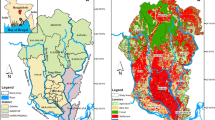Abstract
The three-dimensional groundwater flow model MODFLOW and the one-dimensional consolidation model are coupled and calibrated to simulate the piezometric levels and land subsidence in the complex multi-aquifer system of the lower Central Plain of Thailand. The mathematical models are calibrated against historical data for the period 1955–1990 by considerably updating the system conditions used by previous studies. The aquifer system responses to different pumping schemes are then predicted for the period 1991–2010. The modeling procedure is carried out in close consultation with the Department of Mineral Resources (DMR), Royal Thai Government. The conclusions of the study will allow the DMR to develop and implement updated groundwater management policies, land subsidence control strategies and action programs in the Bangkok Metropolitan Area.
Similar content being viewed by others
References
Asian Institute of Technology (AIT): 1981,Investigation of Land Subsidence Caused by Deep Well Pumping in the Bangkok Area, Comprehensive Report 1978–1981, Submitted to the Office of the National Environment Board, Bangkok, Thailand.
Asian Institute of Technology (AIT) and Department of Mineral Resources (DMR): 1982,Groundwater Resources in the Bangkok Area: Development and Management Study, Comprehensive Report 1978–1982, Submitted to the Office of the National Environment Board, Bangkok, Thailand.
Asian Institute of Technology (AIT): 1987,Extended Simulation Study of Bangkok Aquifer System, Research Report No. 193, submitted to the Department of Mineral Resources (DMR), Ministry of Industry, Royal Thai Government.
Asian Institute af Technology (AIT): 1992,Simulation Study of Bangkok Aquifer System (1991), Research Report No. 251, submitted to the Department of Mineral Resources (DMR), Ministry of Industry, Royal Thai Government.
Bredehoeft, J. D. and Pinder, G. F.: (1970), Digital Analysis of Areal Flow in Multi Aquifer Groundwater Systems: A Quasi Three Dimensional Model,Water Resour Res. 6, 883–888.
DMR: 1991, Personal Communications.
Helm, D. C.: 1975, One Dimensional Simulation of Aquifer System Compaction near Pixley. California, 1. Constant Parameters,Water Resour. Res. 11. 465–478.
Mahadeva, K. T.: 1991,Groundwater Flow Simulation Using MODFLOW, Thesis No. WA-91-9, Asian Institute of Technology, Bangkok, Thailand.
McDonald, M. G. and Harbaugh, A. W.: 1984,A Modular Three Dimensional Finite Difference Ground Water Flow Model, USDI, U.S. Geological Survey, National Center, Reston, Virginia.
Nutalaya, P., Yong, R. N., Chumnankit, T and Buapeng, S.: 1989, Land Subsidence in Bangkok during 1978–1988, paper presented at theWorkshop on Bangkok Land Subsidence-What's Next, 22–23 June, 1989, Bangkok.
Piancharoen, C. and Chuamthaisong, C.: 1976, Groundwater of Bangkok Metropolis, Thailand,Proc. Int. Hydrogeol. Conf. Hydrogeology of Great Sed. Basin, Hungarian Geological Institute / UNESCO, Budapest.
Ramnarong, V. and Buapeng. S: 1991, Mitigation of Groundwater Crisis and Land Subsidence in Bangkok,J. Thai Geosciences 2, 125–137.
Author information
Authors and Affiliations
Rights and permissions
About this article
Cite this article
Onta, P.R., Gupta, A.D. Regional management modeling of a complex groundwater system for land subsidence control. Water Resour Manage 9, 1–25 (1995). https://doi.org/10.1007/BF00877386
Received:
Accepted:
Issue Date:
DOI: https://doi.org/10.1007/BF00877386




